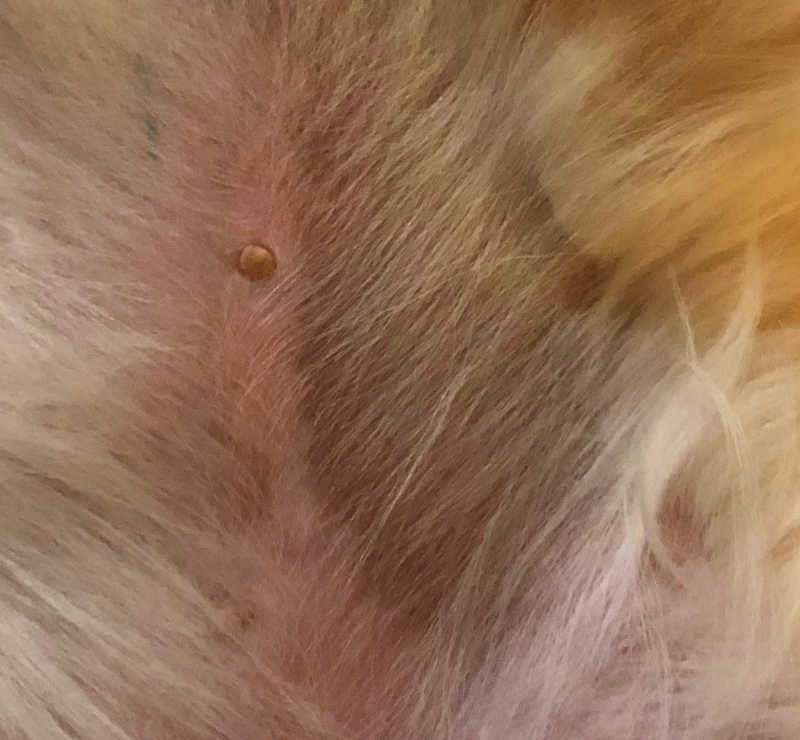Are they in or on the skin and very localised?
If they make up small, discrete lumps (usually round, although the margins may be a little irregular in some cases), surrounded by normal skin, then you’re probably dealing with a “focal pathology”. This means there’s a problem in that one area, but the rest of the skin may be largely unaffected. Important causes include…
Comedones, or blackheads, are a fairly common sign of skin disease, occurring when pores become blocked and fill with cellular or oily material. This may be infected or not but is usually a sign of some dysfunction within the skin. There are several causes to blackheads, and a dog with more than one comedone, or where there seems to be any inflammation, redness or discomfort around the blackhead should be seen by your vet.

Go to the next picture for illustration of the disorder(s)
Skin tumours are quite uncommon in dogs. Several can have a brown/back aspect, are usually dark/black and often irregular (a little like a blackberry embedded in the skin). If you see such presentation evolving over the time, always seek veterinary attention as soon as practical: the earlier these disorders are caught, the more effective treatment is likely to be.
Are the spots caused by material in the coat?
Are they free-floating, and do they come off or move as you stroke the hair? If so, likely causes include…
Dogs who regularly roll around in the dirt or go swimming inevitably pick up mud… and this can easily cause dark spots in the hair. It is important to make sure that they aren’t something more serious though.
If the “black spots” are like little grains of black sand, they may be signs of a flea infestation. The best way to distinguish flea faeces from mud is the Wet Paper Test:
If the smudges are brown, they are probably mud. If, however, they smear to red, then this is digested blood – a sure sign that the spots are actually flea dirt.




Go to the next picture for illustration of the disorder(s))

Flea feaces in dogs coat. It can look like dirt.

Wet Paper Test with flea faeces. Flea faeces smear to red when wet
Flea faeces definitively demonstrate the presence of adult fleas… but unfortunately, they can’t tell us how many fleas are present in the house, just how many have “caught short” on the dog recently. However, as a general rule, the more faeces, the more fleas.
Treatment of the affected dog is essential, preferably using a product recommended by your vet. It is, however, also important to treat the environment where 95% of the flea population is lurking, as eggs, larvae and pupae, waiting to develop and hop back on board. Again, your vet will be able to advise you on the best way to clear an infestation!
Although “dandruff” in dogs is usually pale, whitish “scale”, occasionally the oily residues can dry up and turn darker, showing as brown flakes in amongst the hairs. These don’t usually smear at all on a Wet Paper Test, allowing us to distinguish them from mud and from flea faeces.

Go to the next picture for illustration of the disorder(s)

Nagy zsíros pelyhek és foltok, amely beburkolja a szőrszálakat
Oily flakes are commonly seen disorders triggered by increased sebum production, but you may also see dry flakes in exfoliative disorders. And of course, many dogs will have both! It is normal to find a few flakes, but if there are a lot, this suggests a clinical disorder requiring veterinary investigation.
Management of seborrhoea usually revolves around treating the underlying cause (if known) and restoring the lipid balance of the skin and normalising cell turnover, with ingredients such as Seboliance found in DOUXO® S3 SEB.
What About Black or Brown Spots on a Dog’s Belly?
Black spots on a dog’s belly can be perfectly normal. Some dogs are born with dark spots on the skin as a normal part of their skin coloring. Others tend to develop dark spots on their bellies as they age. The pictures below show two examples of normal black spots or normal dark areas on a dog’s belly:


However, there is a possibility that the spots are a sign of an underlying condition such as skin infection, allergies, endocrine disease, or even cancer, so newly noticed spots should always be brought to the attention of the dog’s veterinarian.
Black Skin Disease | Skin Disease in Dogs | Dr Pallabi Vet
Has part of your dog’s skin become a certain darker colour lately? Does part of your dog’s skin feel or look abnormal compared to the rest of his or her body? There is a long list of signs and changes that are associated with skin conditions in dogs. One of these changes is called hyperpigmentation. Hyperpigmentation is an increase in dark pigmentation of the skin.
Hyperpigmentation is a sign, not a diagnosis. It is not a specific disease; rather, it is secondary change on a dog’s skin. Change in pigment can occur due to a number of reasons, and if darker skin pigment accumulates on the skin, this will cause darkening of the skin. Hyperpigmentation is a term used for increase in the pigmentation on dog skin, which is considered to be more than what is normal for that particular dog.
Hyperpigmentation may be the only change noted, or it may be accompanied by skin that feels velvety or rough to the touch. This may be due to areas of thickened skin where the skin feels rough or velvety. Other skin symptoms that can be noted along with hyperpigmentation include redness of the skin, hair loss, scaling, crusting, and itchiness. Hyper pigmented skin may also appear more moist or sweaty than usual, or may be dry to the touch along with the presence of scaling or dandruff.
